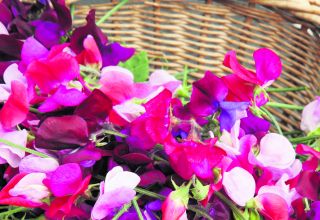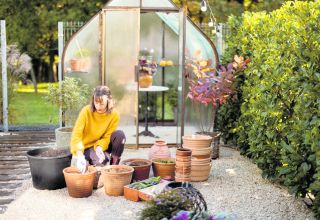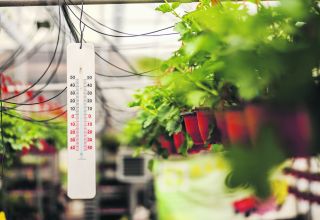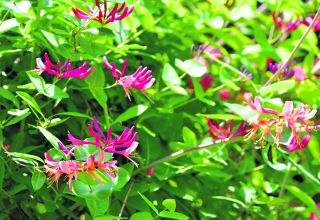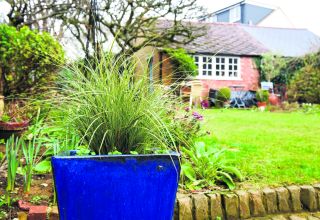
Container gardening is again going through a boom in popularity, not just for small gardens but for gardeners who want plants and vegetables closer to their back door. They provide an easy way to brighten up small spaces and create focal points in larger areas. We look at how to ensure your containers are a success.
Pairing up pots and plants in pleasing compositions is quite simply a wonderful way to garden.
You can even grow perennials, grasses, and dwarf evergreen shrubs in pots to provide year-round interest.
Containers also let you skip the major digging and weed-pulling of border gardening and fast-forward to the fun: designing, planting, and enjoying. You get just enough dirt under your fingernails to feel like you’ve accomplished something. Best of all, potted gardens are close-up delights. They invite you to slow down, notice the details, and savour the scents.
Why grow in containers?
Containers come into their own when soil space is limited, such as in small gardens and on patios, doorsteps and balconies. In some outdoor spaces, a container garden may be the only option for growing plants. You can move them around more easily than plants growing in the ground, and their limited size means they’re great for beginners growing small quantities of veg or herbs, for example.
Almost any type of plant can be grown in a container, from colourful seasonal bedding to more permanent shrubs, climbers and herbaceous varieties.
Perennials are any plant living for at least three years. The term is also commonly used for herbaceous perennials which grow for many years perennials and even small trees. Clipped topiary in a pot makes a great focal point and adds a formal flourish to a front doorstep. Many fruits and vegetables can be successful in pots too, as can some roses. Drought-tolerant plants, such as Mediterranean herbs, are ideal for planting in pots, especially in our warming climate.
Just bear in mind that plants in containers need more watering and feeding than those growing in the ground, as they have only a small amount of compost to sustain them. They are also more susceptible to cold, as the roots are more exposed than those buried deep in the earth, so may need additional protection in winter. Container plants are also prone to waterlogging in winter, so make sure the drainage is good, especially during the wetter seasons.
Vegetable growing in containers – a very personal view
Dorset gardener Ralph Denning has been growing vegetables in containers for over 20 years and has never found limitations on space a problem.
I grew up only knowing a small town centre garden and my parents worked hard to grow things in restricted spaces. They became masters at growing in containers.
From the chives in the big garden pots, to the little pots of mint and coriander sitting on the kitchen windowsill, these experiences were the first to pique my interest in gardening.
As more and more people are looking to branch out in their experimentation with edible crops, it’s becoming very clear that green finger fever isn’t just confined to the countryside.
Urban agriculture is really taking off, with people growing food in the most improbable places: rooftops, balconies, windowsills, and every other little nook and cranny that is available to them.
Growing food in pots is the easiest way to do this. Able to fit perfectly in little corners, container growing offers the perfect way for people with limited space to get into edible gardening.
Pots are obviously not just for town dwellers with confined space– they can also offer a valuable alternative if your soil is too poor to grow in and can often be much more accessible to growers with physical differences and disabilities.
If you’re growing a tree or shrub in a large container, you should replenish the compost every year or two. The ideal time to do this is between February and May. Doing so will improve the compost structure and provide a fresh supply of nutrients, which can be lost quickly in pots and containers.
Gravel or stones can also be at the bottom of a planter, but only to thinly cover and protect the drainage holes and not as a thick solid layer. A thick layer can reduce the space for plant roots and potentially raise the water table in the pot, which can increase the saturation of the soil around plant roots.
There are a couple rules of thumb to help you choose the right size pot for your plants: for a mixture of plants, look for containers at least 12 inches wide. Annuals usually need at least eight inches of soil depth, while grasses and shrubs may need two or three times that amount. The ideal container has straight sides or ones that flare out at the top for easy access.
So, what kind of vegetables are on offer for container growers, and which will provide the best yields when grown in a small space? Here, we look at the top vegetable varieties to grow in pots.
Beans
Beets
Chard
Chilli Peppers
Kale
Lettuce
Onions
Radishes
Spinach
Sweet Peppers
Tomatoes
As a rule, hybrid and dwarf varieties of plants are usually a good bet in pots, as they require less space to grow.
Summer wouldn’t be complete, without the taste of juicy tomatoes. And the good news is they’re easy to grow in pots and growing bags, if you have a sunny spot. It’s a little late to sow tomato seeds now, but you can buy tomato plug plants online now, and pot them up. Then, after all risk of frost is past, you can plant them out into a growing bag or any large container you have.
If you only have space for a small pot or windowbox, there’s still plenty you can grow. You can grow lettuce and salad leaves in small, shallow pots, as they don’t need a deep root run. Sow seeds now and you can be harvesting fresh, baby salad leaves in just weeks – ideal if you’re impatient or gardening with kids. They’ll do best in a slightly shady spot.
Carrots need really free-draining soil, that’s free of stones.
Growing carrots in a pot is an easy way to give them this. If you’re growing traditional, long carrots, then make sure you use a deep container. If you only have a shallow container or windowbox, you can still grow carrots – just choose a short variety, such as ‘Parmex’ or ‘Paris Market – Atlas’.
Picking pots to grow in
Aesthetics aside, there are also practical concerns when picking pots.
If you’ll be placing pots on a deck , a patio or a rooftop, look for lightweight materials, such as metal or composite. These and some glazed ¬ceramic pots also have the advantage of being nonporous, so they keep soil moist. Porous unglazed terra-cotta gets a wonderful patina over time but allows soil to dry out more quickly.
Any pot needs drainage holes so roots don’t get waterlogged; these should be covered with pottery shards, stones, or a small piece of screening to keep soil from migrating out.
If containers sit on a wooden deck, consider using pot feet or a plant stand to elevate them so that the decking doesn’t stay wet, which will lead to rot.
An old tin bath is the ideal size for a miniature herb garden – mix the herbs with edible or medicinal plants for an even more attractive look. Find out how to make this herb container using red-veined sorrel, basil, salad burnet, calendula and pelargonium.

Wooden box
Wine or wooden boxes make the ideal container for herbs and cut-and-come-again salads. Alternatively, fill it with alpine plants and succulents to make an attractive, year-round display.
Metal trough
Old metal farm troughs are now highly sought after by gardeners. They are ideal for all manner of plants, including herbs, strawberries, tomatoes and more. Be sure to drill holes in the bottom to ensure good drainage.

Belfast sink
A Belfast sink is a beautiful choice for all manner of plants – stick to one type for maximum effect, such as alpines, succulents, herbs, carnivorous plants. Or try a beautiful acer and bleeding heart display, perfect for a semi-shaded spot.
Metal bucket
A metal bucket makes an attractive (and portable) container for herbs or ornamental plants. Be sure to add newspaper or bubble wrap around the insides to prevent the compost from getting too hot.

Hessian sacks
Hessian sacks give an organic, natural look and naturally provide good drainage (you might want to stand the sack on something to stop it staining your paving). They’re ideal for growing potatoes, baby veg, strawberries and even herbs.
Terracotta/clay
These look attractive, but unglazed pots are porous so dry out more quickly than other materials. Terracotta is also prone to cracking in winter, so choose frost-proof pots, rather than just frost-resistant. High-quality pots can be expensive, but if well looked after they can last for many years.

Secrets to successful container growing
Check that your container drains well. It must have one or two drainage holes in the base to allow excess water to escape. Keep the holes from getting blocked up with compost by adding a couple of inches of gravel as the base of the container. Avoid using other materials which can block the holes.
Avoid using garden soil in containers – it won’t drain well enough and may contain pests. Instead use multi peat-free compost for seasonal plantings and a mixture of John Innes’
No 2 potting compost for plants that you plan to keep in a container for more than a year.
Give plants a thorough watering both before and after planting.
Position plants at the same depth they were growing at previously. With shrubs and trees ensure the soil mark on the stem is level with the surface of the compost.
Leave a gap between the surface of the compost and the rim to allow for watering.
Raise the pot off the ground on bricks or ‘pot feet’ to ensure water drains out easily, especially in winter. This will prolong the life of container plants made from perishable material such as wood.
Choose whether to add a mulch.
Keep long term plants thriving by replacing the top 5cms of compost every spring. Adding a good handful of blood fish and bonemeal will also give them a boost.

